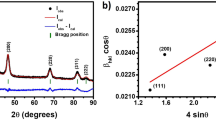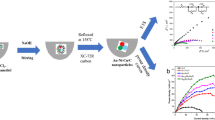Abstract
In this paper, the optimization of hydrogen (H2) production by ammonia borane (NH3BH3) over PdCoAg/AC was investigated using the response surface methodology. Besides, the electro-oxidation of NH3BH3 was determined and optimized using the same method to measure its potential use in the direct ammonium boran fuel cells. Moreover, the ternary alloyed catalyst was synthesized using the chemical reduction method. The synergistic effect between Pd, Co and Ag plays an important role in enhancement of NH3BH3 hydrolysis. In addition, the support effect could also efficiently improve the catalytic performance. Furthermore, the effects of NH3BH3 concentration (0.1–50 mmol/5 mL), catalyst amount (1–30 mg) and temperature (20°C–50°C) on the rate of H2 production and the effects of temperature (20°C–50°C), NH3BH3 concentration (0.05–1 mol/L) and catalyst amount (0.5–5 µL) on the electro-oxidation reaction of NH3BH3 were investigated using the central composite design experimental design. The implementation of the response surface methodology resulted in the formulation of four models out of which the quadratic model was adjudged to efficiently appropriate the experimental data. A further statistical analysis of the quadratic model demonstrated the significance of the model with a p-value far less than 0.05 for each model and coefficient of determination (R2) of 0.85 and 0.95 for H2 production rate and NH3BH3 electrroxidation peak current, respectively.
Similar content being viewed by others
References
Andrews J, Shabani B. Re-envisioning the role of hydrogen in a sustainable energy economy. International Journal of Hydrogen Energy, 2012, 37(2): 1184–1203
Tiwari A, Pandey A. Cyanobacterial hydrogen production—a step towards clean environment. International Journal of Hydrogen Energy, 2012, 37(1): 139–150
Moriarty P, Honnery D. Hydrogen’s role in an uncertain energy future. International Journal of Hydrogen Energy, 2009, 34(1): 31–39
Acar C, Dincer I. Comparative assessment of hydrogen production methods from renewable and non-renewable sources. International Journal of Hydrogen Energy, 2014, 39(1): 1–12
Dincer I, Acar C. Review and evaluation of hydrogen production methods for better sustainability. International Journal of Hydrogen Energy, 2015, 40(34): 11094–11111
Ball M, Weeda M. The hydrogen economy–vision or reality? International Journal of Hydrogen Energy, 2015, 40(25): 7903–7919
Meeks N D, Baxley S. Fuel cells and the hydrogen economy. Chem Eng Prog, 2016, 112(7): 34–37
Granovskii M, Dincer I, Rosen M A. Economic and environmental comparison of conventional, hybrid, electric and hydrogen fuel cell vehicles. Journal of Power Sources, 2006, 159(2): 1186–1193
Van Mierlo J, Maggetto G, Lataire P. Which energy source for road transport in the future? A comparison of battery, hybrid and fuel cell vehicles. Energy Conversion Management, 2006, 47(17): 2748–2760
Wang Y, Meng W, Wang D, Wang Z R, Zou K L, Cao Z Q, Zhang K, Wu S W, Li G D. Ultrafine cobalt-molybdenum-boron nanocatalyst for enhanced hydrogen generation property from the hydrolysis of ammonia borane. International Journal of Hydrogen Energy, 2019, 44(41): 23267–23276
Appleby A J. Fuel cell technology: status and future prospects. Energy, 1996, 21(7–8): 521–653
Amendola S C, Sharp-Goldman S L, Janjua M S, Kelly M T, Petillo P J, Binder M. An ultrasafe hydrogen generator: aqueous, alkaline borohydride solutions and Ru catalyst. Journal of Power Sources, 2000, 85(2): 186–189
Miesse C M, Jung W S, Jeong K J, Lee J K, Lee J, Han J, Yoon S P, Nam S W, Lim T H, Hong S A. Direct formic acid fuel cell portable power system for the operation of a laptop computer. Journal of Power Sources, 2006, 162(1): 532–540
Dillon R, Srinivasan S, Arico A S, Antonucci V. International activities in DMFC R&D: status of technologies and potential applications. Journal of Power Sources, 2004, 127(1–2): 112–126
Zadick A, Dubau L, Artyushkova K, Serov A, Atanassov P, Chatenet M. Nickel-based electrocatalysts for ammonia borane oxidation: enabling materials for carbon-free-fuel direct liquid alkaline fuel cell technology. Nano Energy, 2017, 37: 248–259
Wu D F, Ouyang L Z, Huang J M, Liu J W, Wang H, Shao H, Zhu M. Synthesis and hydrogen storage property tuning of fit Zr(BH4)4. 8NH3 via physical vapour deposition and composite formation. International Journal of Hydrogen Energy, 2018, 43(41): 19182–19188
Zhang X B, Yan J M, Han S, Shioyama H, Yasuda K, Kuriyama N, Xu Q. A high performance anion exchange membrane-type ammonia borane fuel cell. Journal of Power Sources, 2008, 182(2): 515–519
Zhang X B, Han S, Yan J M, Chandra M, Shioyama H, Yasuda K, Kuriyama N, Kobayashi T, Xu Q. A new fuel cell using aqueous ammonia-borane as the fuel. Journal of Power Sources, 2007, 168(1): 167–171
Ouyang L Z, Chen W, Liu J W, Felderhoff M, Wang H, Zhu M. Enhancing the regeneration process of consumed NaBH4 for hydrogen storage. Advanced Energy Mater, 2017, 7(19): 1700299
Chen W, Ouyang L Z, Liu J W, Yao X D, Wang H, Liu Z W, Zhu M. Hydrolysis and regeneration of sodium borohydride (NaBH4): a combination of hydrogen production and storage. Journal of Power Sources, 2017, 359: 400–407
Hua T Q, Ahluwalia R K. Off-board regeneration of ammonia borane for use as a hydrogen carrier for automotive fuel cells. International Journal of Hydrogen Energy, 2012, 37(19): 14382–14392
Rees N V, Compton R G. Carbon-free energy: a review of ammonia-and hydrazine-based electrochemical fuel cells. Energy & Environmental Science, 2011, 4(4): 1255–1260
Tan Z H, Ouyang L Z, Liu J W, Wang H, Shao H Y, Zhu M. Hydrogen generation by hydrolysis of Mg-Mg2Si composite and enhanced kinetics performance from introducing of MgCl2 and Si. International Journal of Hydrogen Energy, 2018, 43(5): 2903–2912
Chandra M, Xu Q. A high-performance hydrogen generation system: transition metal-catalyzed dissociation and hydrolysis of ammonia-borane. Journal of Power Sources, 2006, 156(2): 190–194
Li X G, Liu T, Sato M, Takahashi S. Synthesis and characterization of Fe-Ti nanoparticles by nitrogen plasma metal reaction. Powder Technology, 2006, 163(3): 183–187
Rakap M, Kalu E E, Ozkar S. Polymer-immobilized palladium supported on TiO2 (Pd-PVB-TiO2) as highly active and reusable catalyst for hydrogen generation from the hydrolysis of unstirred ammonia-borane solution. International Journal of Hydrogen Energy, 2011, 36(2): 1448–1455
Sahiner N, Ozay O, Aktas N, Inger E, He J B. The on demand generation of hydrogen from Co-Ni bimetallic nano catalyst prepared by dual use of hydrogel: as template and as reactor. International Journal of Hydrogen Energy, 2011, 36(23): 15250–15258
Yuzawa H, Yoshida T, Yoshida H. Gold nanoparticles on titanium oxide effective for photocatalytic hydrogen formation under visible light. Applied Catalysis B: Environmental, 2012, 115–116: 294–302
Turhan T, Avcibasi Y G, Sahiner N. Versatile p(3-sulfopropyl methacrylate) hydrogel reactor for the preparation of Co, Ni nanoparticles and their use in hydrogen production. Journal of Industrial and Engineering Chemistry, 2013, 19(4): 1218–1225
Tong D G, Han X, Chu W, Chen H, Ji X Y. Preparation of mesoporous Co-B catalyst via self-assembled triblock copolymer templates. Materials Letters, 2007, 61(25): 4679–4682
Sahiner N, Sagbas L. The use of poly(vinyl phosphonic acid) microgels for the preparation of inherently magnetic Co metal catalyst particles in hydrogen production. Journal of Power Sources, 2014, 246: 55–62
Yao Q L, Lu Z H, Yang Y W, Chen Y Z, Chen X S, Jiang H L. Facile synthesis of graphene-supported Ni-CeOx nano-composites as highly efficient catalysts for hydrolytic dehydrogenation of ammonia borane. Nano Research, 2018, 11(8): 4412–4422
Choi S M, Seo M H, Kim H, Kim W B. Synthesis and characterization of graphene-supported metal nanoparticles by impregnation method with heat treatment in H2 atmosphere. Synthetic Metals, 2011, 161(21–22): 2405–2411
Ozay O, Aktas N, Inger E, Sahiner N. Hydrogel assisted nickel nanoparticle synthesis and their use in hydrogen production from sodium boron hydride. International Journal of Hydrogen Energy, 2011, 36(3): 1998–2006
Fernandes R, Patel N, Miotello A. Hydrogen generation by hydrolysis of alkaline NaBH4 solution with Cr-promoted Co-B amorphous catalyst. Applied Catalysis B: Environmental, 2009, 92 (1–2): 68–74
Wang S, Zhang D, Ma Y Y, Zhang H, Gao J, Nie Y T, Sun X H. Aqueous solution synthesis of Pt-M (M = Fe, Co, Ni) bimetallic nanoparticles and their catalysis for the hydrolytic dehydrogenation of ammonia borane. ACS Applied Materials & Interfaces, 2014, 6(15): 12429–12435
Tano T, Esumi K, Meguro K. Preparation of organopalladium sols by thermal-decomposition of palladium acetate. Journal of Colloid and Interface Science, 1989, 133(2): 530–533
Bezerra M A, Santelli R E, Oliveira E P, Villar L S, Escaleira L A. Response surface methodology (RSM) as a tool for optimization in analytical chemistry. Talanta, 2008, 76(5): 965–977
Ling Z, Cao J, Zhang W, Zhang Z, Fang X, Gao X. Compact liquid cooling strategy with phase change materials for Li-ion batteries optimized using response surface methodology. Applied Energy, 2018, 228: 777–788
Yılmaz Ş, Ecer Ü, Şahan T. Modelling and optimization of As(III) adsorption onto thiol-functionalized bentonite from aqueous solutions using response surface methodology approach. ChemistrySelect, 2018, 3(32): 9326–9335
Çelik Kazici H, Yildiz F, İzgi M S, Ulaş B, Kivrak H. Novel activated carbon supported trimetallic PdCoAg nanoparticles as efficient catalysts for the hydrolytic dehydrogenation of ammonia borane. International Journal of Hydrogen Energy, 2019, 44(21): 10561–10572
Şahan T, Erol F, Yılmaz Ş. Mercury(II) adsorption by a novel adsorbent mercapto-modified bentonite using ICP-OES and use of response surface methodology for optimization. Microchemical Journal, 2018, 138: 360–368
Hitit Z Y, Lazaro C Z, Hallenbeck P C. Hydrogen production by co-cultures of Clostridium butyricum and Rhodospeudomonas palustris: optimization of yield using response surface methodology. International Journal of Hydrogen Energy, 2017, 42(10): 6578–6589
Zhang X B, Han S, Yan J M, Shioyama H, Kuriyama N, Kobayashi T, Xu Q. Electrochemical oxidation of ammonia borane on gold electrode. International Journal of Hydrogen Energy, 2009, 34(1): 174–179
Smiljanić M, Srejic I, Potocnik J, Mitric M, Rakocevic Z, Strbac S. Synergistic electrocatalytic effect of Pd and Rh nanoislands co-deposited on Au(poly) on HER in alkaline solution. International Journal of Hydrogen Energy, 2018, 43(42): 19420–19431
Acknowledgements
This work was financially supported by the Scientific Research Projects Department of Van Yü züncüYıl University (Project No: FYL-2018-6571).
Author information
Authors and Affiliations
Corresponding authors
Rights and permissions
About this article
Cite this article
Çelık Kazici, H., Yilmaz, Ş., Şahan, T. et al. A comprehensive study of hydrogen production from ammonia borane via PdCoAg/AC nanoparticles and anodic current in alkaline medium: experimental design with response surface methodology. Front. Energy 14, 578–589 (2020). https://doi.org/10.1007/s11708-020-0808-7
Received:
Accepted:
Published:
Issue Date:
DOI: https://doi.org/10.1007/s11708-020-0808-7




